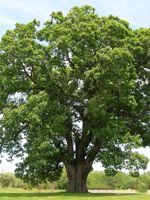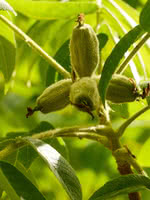Mon-Fri 9am - 5pm Mountain time
White Oak vs Butternut (White Walnut)
Quercus alba
Juglans cinerea
White Oak is large, long-lived tree with an irregular trunk divided into spreading, often horizontal, stout branches. A highly adaptable tree, White Oak features green acorns and beautiful green leaves that turn red-purple in the fall.
With a huge growth in bourbon and scotch over the past few decades there is an emerging shortage of white oak that is the primary tree used for cask barrels and aging.
Note: Most Oak species can be considered toxic for many animals.
Butternut is one of the few walnut varieties native to Canada. The nuts are sought after for their mild, sweet, and oily taste. Ensure this tree is planted in full sun and well-drained soil for best results.
Butternut is self-fertile but it has better yields when planted near other butternuts. It can survive in zone 2, but reliably produces nuts in zone 3.
A top CO2 absorbing species. Experts think this tree may help climate change more than others.

